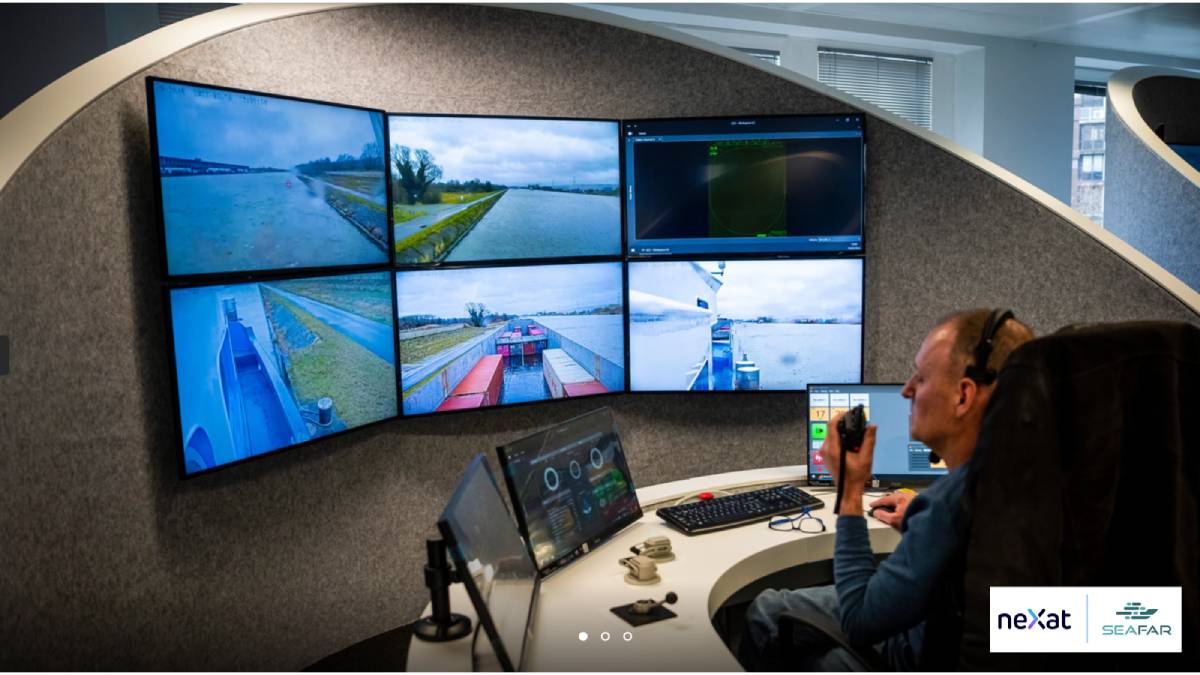
The incredibly busy Port of Antwerp had a problem – they had more large cargo ships that needed guiding into port than they had captains. Luckily, there was an innovative solution to this captain shortage – have captains work remotely in a centralized location, increasing efficiency and enabling them to service more cargo ships in the same amount of time.
Liberty Global’s Belgian subsidiary, Telenet, and Nokia successfully demonstrated a capability that would, “…allow remotely-located captains to operate vessels more safely and efficiently, supported by real-time data made available through ultra-low latency network capabilities and zero-touch automation.”
However, piloting a ship into port is a delicate, dangerous and sensitive operation. The recent tragedy involving the Francis Scott Key Bridge in Baltimore is evidence of how destructive it can be when a massive cargo ship loses control.
For the innovative program at the Port of Antwerp to be successful, network connectivity would need to be assured, the connection between the captain and ship would need incredibly low latency and the data traveling over the network would need to be prioritized and protected.
This was accomplished with advanced technologies, including Nokia’s Network as Code Platform, a suite of APIs and developer tools that allow application developers to build network visualization and management into their applications.
These network APIs and other technologies enabled the creation of a 5G standalone network built in the cloud that delivered “…reliable, high-quality, low-latency connectivity, which existing commercial networks do not provide….[without] the need to deploy a dedicated and expensive mobile communication infrastructure.”
While this project has helped to increase operational efficiency at Europe’s second-busiest port, it’s just one of many potential use cases for network APIs. But what are network APIs, and what capabilities do they enable?
Enabling New Capabilities…and a New Industry
“Network APIs are, in fact, APIs that are made especially for networking equipment, including networking hardware like routers,” explained Michel Dothey, the CCO and Co-Founder of neXat, an operator-agnostic satellite service provider. “These APIs make it possible to automate the configuration of the network. They also make it possible to configure the network remotely.”
But network APIs aren’t one of the telecom industry’s hottest topics because they enable organizations to manage and configure their own networks more easily. These solutions are becoming a hot commodity because they allow telcos and other network operators to give the end user network access, control or configuration capabilities. In fact, network APIs are already becoming big business for telecom companies, which can profit every time an API “call” occurs.
“…enterprise developers are very familiar with the concept of consuming network, messaging, and email-related resources via an API call,” said John Byrne, an experienced Analyst covering the telecommunication industry for analyst firm IDC. “If you are waiting for an Uber and getting a call from your driver, that’s being facilitated by network APIs. There is a market here already that is healthy and preexisting.”
The potential that network APIs hold as a revenue stream for telecom companies is so significant that they’re now exploring ways in which to make them usable and available for personnel outside of the end user’s IT department.
“The focus is now on providing and packaging [network APIs] in a way where it’s consumable by a non-tech person,” Byrne explained. “If you are in the marketing or sales department, you can consume these in a low code, no code environment, and build use cases that make sense in your context within the organization.”
With network APIs opening new revenue streams for telcos – even among end users who are not technologists – it’s understandable why the industry is so focused on their development and deployment. It also explains why Nokia announced the launch of a Network Exposure Platform (NEP) just last month. The NEP is, “a new software offering that will expand and simplify the number of operator network APIs available to developers.”
But are network APIs being used in the satellite industry? And, if so, what benefits could they deliver to satellite providers and their customers?
 Unmanned remote ship navigation. (Source: neXat)
Unmanned remote ship navigation. (Source: neXat)
Dashboards, Dedicated Capacity and Other Capabilities
Many experts and analysts watching the network API market in the telecom industry have yet to see the same growth and revenue opportunities for network APIs in the satellite industry. “Theoretically there is no reason why satellite couldn’t be built into the network API story,” Byrne said. “[But] it is not part of any of the development that we are currently seeing, and I don’t see that changing realistically for the next three years at a minimum.”
However, while there may not be significant revenue streaming into satellite operators from network API calls today, that doesn’t mean network APIs aren’t being used in the satellite industry. According to Dothey, network APIs are responsible for the entire neXat story and the company’s success.
In 2011, neXat began its journey by reselling SES satellite services to customers in need of satellite connectivity in Africa. These services were offered through a network of local distributors that sold the service, offered installation services and then provided the first level of technical support for customers. Unfortunately, reselling a solution from a third party left distributors with very little insight into how much bandwidth was used, or the status of the network.
“These distributors were offering their customers limited, first-level technical support, but they were totally blind,” Dothey explained. “There was a limited amount of capacity that we could offer, and when that threshold was met, the service was either stopped or throttled down. This led to customer complaints, but the distributors couldn’t know if it was a network issue or if the amount of capacity was exhausted.”
Network APIs offered a solution for neXat, its distributors and the customers it was servicing in Africa. By leveraging the APIs offered by the hub and hardware manufacturers, neXat was able to construct dashboards that gave distributors the insight they needed to better understand what was happening on the network, how much capacity was used and whether service had been turned off or throttled back.
“We began building our OSS/BSS platform to address this problem. Thanks to the APIs that were available from the hub manufacturers, we were able to build a dashboard that showed capacity consumption, available bandwidth and terminal information,” said Dothey. “This dashboard gave our local distributors the basic information they needed to offer customers that first level of support.”
Visualization and dashboard construction is just one of many use cases for network APIs in the satellite industry. There are numerous reasons why satellite customers might want to manage or configure their networks to meet their specific requirements.
For example, U.S. military customers could want dedicated, low-latency and assured network connectivity for upcoming missions in an austere environment with no trusted terrestrial networks.
“Let’s say the U.S. Department of Defense (DoD) is conducting a training mission in the Pacific in mid-September. They would traditionally have to work with their COMSATCOM partner weeks in advance to configure their network and deliver the requisite satellite capacity,” Dothey said. “With network APIs, they could provision the network needed to service a specific number of terminals with a specific amount of capacity for a specific amount of time. They could do this on their own, automatically via APIs. And, if the mission changes, they can make changes to the network in minutes instead of days or months.”
Standards and Interoperability
While the potential benefits that network APIs could deliver for satellite users are enormous, some challenges still remain to their wider use and adoption. One of these challenges is the lack of a standard network API that can simplify application development processes for developers. This is consistent for network APIs both in the telecom and satellite industries.
“To get scale and real interest from the app developers, the [telecom] industry needs a standard API so that developers can access just one interface to integrate with multiple telco networks,” said Stuart Daughtridge, the Vice President of Advanced Technology at Kratos. “If the mobile world is successful in developing and monetizing this standard API for app management of their networks, this same concept could be applied to satellite networks.”
Should a standard network API be developed and adopted that could be used across both the telecom and satellite industries, the doors would be open for more end-user control of networks, and the increased integration of satellite and terrestrial networks. This would help to extend the reach of terrestrial networks to every corner of the globe, while also increasing the resiliency and security of critical communications networks.
As Robert Bell, the Executive Director of the World Teleport Association explained in a statement to Constellations:
“The biggest opportunities of the future will require the technology and business practices of network operators to integrate multi-orbit satcom in all its complexity with the multiple paths of terrestrial telecom in a seamless whole. The open API standards emerging from the TM Forum and Metro Ethernet Forum will enable such integration to cross networks and power infrastructure sharing where it makes business sense. At the same time, terrestrial telecom will find benefit in satellite’s ability to connect without touching the terrestrial network, so that private networks for critical infrastructure can be truly safe from cyber threats.”
Explore More:
A Field Guide to 5G Standards in Satcom/Telecom Integration
Ready for Mainstream? Challenges of Satellite 5G
3 Technology Approaches Shaping the Direct-to-Device Market
Is Cloud Native Make or Break for Satellite 5G?
